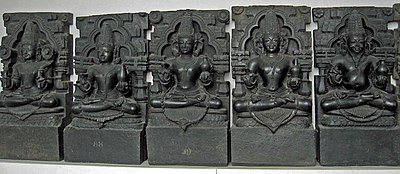Navagraha
Navagraha ( Sanskrit , नवग्रह, "nine planets" or "nine kingdoms", from nava , "nine" and gráha , "grasp", "seize", "hold on") denotes the nine planets in traditional Hindu astronomy ( Jyotisha ) personified heavenly figures. In contrast to Greek astronomy, all planetary gods in Hinduism are male.
| Surname | Correspondence |
|---|---|
| Surya (सूर्य) | Sun |
| Chandra (चंद्र) | moon |
| Mangala (मंगल) | Mars |
| Budha (बुध) | Mercury |
| Brihaspati (बृहस्पति) | Jupiter |
| Shukra (शुक्र) | Venus |
| Shani (शनि) | Saturn |
| Rahu (राहु) | Head of the serpent demon ascending lunar knot |
| Ketu (केतु) | Tail of the serpent demon descending lunar knot |

|

|
|
|
Navagraha sculptures from the Konark Sun Temple ( British Museum ). From left to right: Surya, Chandra, Mangala, Budha, Brihaspati, Shukra, Shani, Rahu, Ketu.
|
||
Nava means “nine”. Graha is sometimes translated as "planet". However, the sun, moon and Rahu and Ketu are not planets in the sense of today's astronomy . Sometimes graha is also translated as "heavenly body", but Rahu and Ketu are not heavenly bodies in the sense of western astronomy either. A third translation would be “demigod”, but Rahu and Ketu are asuras and not devas . All Navagrahas have in common that they move relative to the fixed zodiac signs in the background.
In the Kaveri Delta in Tamil Nadu there is a group of nine Navagraha temples , each dedicated to one of the nine Navagrahas. Another well-known Navagraha temple is located in Gauhati in Assam .
literature
- Marianna Kropf: Ritual traditions of the planetary deities (Navagraha) in the Kathmandu valley. Structures - practices - worldviews. (Dissertation) University of Heidelberg, 2005
- Stephen Markel: Origins of the Indian planetary deities. ( Studies in Asian thought and religion, Volume 16) Edwin Mellen Press, Lewiston (New York) 1995
- Stephen Markel: The Genesis of the Indian Planetary Deities. In: East and West, Volume 41, No. 1/4, December 1991, pp. 173-188